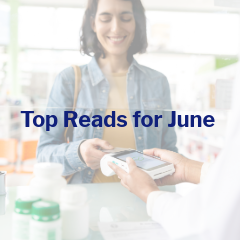
The top three Prescribed Perspectives articles downloaded by health systems in June.
Learn how partnering with McKesson can maximize PAP awareness to help health systems achieve more.
By
Date
November 04, 2022

By: O'Mally Monahan
Read time: 6 minutes
While the COVID-19 pandemic accelerated certain trends like telehealth and digitization, it carved larger disparities into long-standing health challenges like adherence and abandonment. What do adherence and abandonment have in common? Medication abandonment and lack of adherence to medicines significantly impact health outcomes, particularly for patients with chronic disease and who are lower in income.
According to the recent KFF data, health care debt is a burden for a large share of Americans. About half of U.S. adults say they have difficulty affording health care costs, and 4 in 10 U.S. adults say they have delayed or gone without medical care in the last year due to cost.
4 out of 10 adults have delayed care due to cost.1
These staggering statistics don’t just represent those without insurance. About one-third of insured adults worry about affording their monthly health insurance premiums and 44% worry about affording their deductible before health insurance kicks in.2
Adherence and abandonment are two KPIs that health systems should aim to tackle with strategic planning initiatives. One way to address these areas is by standardizing the use of Patient Assistance Programs. Patient Assistance Programs can remove access barriers, such as cost, by making treatment more affordable, reducing abandonment, and increasing adherence.
Prescription abandonment is understood as a prescription written by a prescriber, but never picked up at the pharmacy or obtained by the patient. The main reason for abandonment should come as no surprise – it is cost.
There is ample data to back up this claim: A 2018 IQVIA study determined, “Patients with higher out-of-pocket costs are more likely to abandon their new prescriptions at the pharmacy. For instance, 69% of commercial patients did not start therapy when faced with out-of-pocket costs exceeding USD 250. In contrast, only 11% of patients whose final out-of-pocket costs were less than $30 did not start therapy.” 4
More evidence shows that when patient out-of-pocket costs increase so does the likeliness of abandonment. Abandonment can range from 8% (drug cost $0 – 9.99) to 21 % (drug cost $40.00 – 49.99). As costs escalate beyond $250, prescription abandonment can reach as high as 69%. And as drug costs continue to rise so will this abandonment curve. In 2017 the average drug claim for patients with high deductibles and commercial insurance was $270 in 2020 it is likely closer to $300.5
Having Patient Assistance Program advocates in a health system can help identify programs that cut out-of-pocket expenses by offering financial support or free drugs when needed. Assistance can range from $10 discounts to providing drugs completely free of charge. Best of all, health systems don’t have to fund these programs organically.
Medication non-adherence—when patients don't take their medications as prescribed—is unfortunately fairly common, especially among patients with chronic disease. Medication non-adherence accounts for 10% of all hospital admissions, and results in 125,000 deaths annually.6 Medication adherence can have a tremendous impact on health outcomes, and overall healthcare costs for both patients and the health systems. Adherence to prescribed medications is associated with improved clinical outcomes for chronic disease management and reduced mortality from chronic conditions.7
Having a standardized patient assistance program strategy across the health system is the best way to address adherence and abandonment.
It is important for health system professionals to understand why patients don't take their medications. With many patient-centered interventions available such as electronic reminders, offering 90-day supplies, and automatic refills, health systems should not overlook dedicated patient advocates as part of their adherence strategy. Having a standardized patient assistance program strategy across the health system is the best way to address adherence and abandonment.
Patient Assistance Programs, which are often available for branded name drugs, have a measurable impact on patient’s access to their medicines: An IQVIA study showed if co-pay cards, which are a form of Patient Assistance Program, had not been used, patients would be almost three times as likely to abandon their medicines at the pharmacy.
Patient Assistance Programs are sponsored to help lower the cost of medication. In turn, lower medication costs directly impact adherence and abandonment. Health systems should focus their attention on maximizing their Patient Assistance Program reach—from behavioral health and oncology clinics to the emergency room and inpatient stays, awareness is key to a successful Patient Assistance Program.
Health systems can further their mission to deliver high-quality, patient-centered care by collaborating with patients, payers, and pharmaceutical companies to address the patient burden of financial toxicity. But ultimately, addressing and promoting awareness is the key to a successful program.
Depending on your health system’s PAP needs and capabilities, McKesson Patient Assistance Program (PAP) Reimbursement and Revenue Recovery Management solution can help provide support. Whether it is fully managing your PAP program, or simply providing the best-in-class technology for you to run it in-house through our new PAP Recovery Navigator, this allows health systems staff to focus on what really matters – your patients.
McKesson RxO’s PAP Reimbursement and Revenue Recovery Management solutions help identify revenue opportunities
Insightful perspectives and support you can count on
Click here to learn how partnering with McKesson on your Patient Assistance Program needs can help your health system achieve more.
1https://www.kff.org/health-costs/issue-brief/americans-challenges-with-health-care-costs/#:~:text=About%20four%20in%20ten%20U.S.,putting%20off%20due%20to%20cost
2https://www.kff.org/health-costs/issue-brief/americans-challenges-with-health-care-costs
3 Amundsen Consulting analysis for PhRMA; IMS FIA; Rx Benefit Design, 2017
4https://www.iqvia.com/locations/united-states/library/case-studies/patient-affordability-part-two
5 Patient Affordability Part Two, The Implications for Patient Behavior and Therapy Consumption, IQIVIA Institute, 2018
6 IQVIA Medicine Use and Spending in the US: A Review of 2016 and Outlook to 2021
7https://pubmed.ncbi.nlm.nih.gov/22486599/